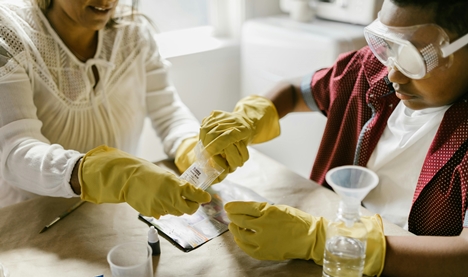
Easy Science Experiments to Do at Home
Science is not limited to labs or classrooms; it can be explored right at home with simple materials. By engaging in easy, fun, and educational science experiments, children can not only learn basic scientific principles but also foster their curiosity and creativity. Below, we explore a few easy science experiments that can be done with everyday household items, which are both engaging and educational.
1. Baking Soda and Vinegar Volcano
One of the classic science experiments that children enjoy is the baking soda and vinegar volcano. This experiment demonstrates the chemical reaction between a base (baking soda) and an acid (vinegar) to produce carbon dioxide gas, which creates a fizzy explosion resembling a volcanic eruption.
Materials Needed:
- Baking soda
- Vinegar
- A small container or bottle
- Dish soap (optional)
- Food colouring (optional)
How to Do It:
- Fill a small container with about 2-3 tablespoons of baking soda.
- Add a few drops of dish soap and food colouring to enhance the effect.
- Pour vinegar into the container and watch the bubbly eruption occur as the acid reacts with the base.
This experiment is a fantastic way to introduce children to chemical reactions and the concept of acids and bases.
2. Floating Egg Experiment
This experiment helps to explain density and buoyancy using a simple item like an egg. It’s an interesting way to show how objects float or sink depending on the density of the liquid they are placed in.
Materials Needed:
- A glass of water
- Salt
- An egg
How to Do It:
- Fill a glass with water and gently place the egg into it. Notice that it sinks to the bottom.
- Now, add salt to the water and stir it until the salt dissolves. Keep adding salt until the egg starts to float.
By adding salt to the water, you increase its density, allowing the egg to float. This experiment is a great way to visually demonstrate the concept of density and how it influences buoyancy.
3. Rainbow in a Glass
This simple experiment allows you to create a colourful rainbow using sugar, water, and food colouring. It demonstrates how different concentrations of sugar create layers of liquid with varying densities.
| Material | Quantity |
|---|---|
| Sugar | 4 tablespoons |
| Water | 4 cups (divided) |
| Food colouring | 4 different colours |
| A glass | 1 |
How to Do It:
- Dissolve different amounts of sugar in each of the four cups of water. For example, add 1 tablespoon in the first cup, 2 tablespoons in the second, and so on.
- Colour each cup of water with different food colouring.
- Slowly pour each coloured water, starting with the highest sugar concentration, into the glass, using a spoon to avoid mixing.
As a result, you'll create a rainbow effect where the layers remain separate due to the difference in densities.
4. Invisible Ink with Lemon Juice
Creating invisible ink with lemon juice is another fun experiment that teaches children about oxidation. When heat is applied to the lemon juice, the acid in the juice reacts with oxygen, revealing the hidden message.
Materials Needed:
- Lemon juice
- A cotton swab or paintbrush
- Paper
- A heat source (like a candle or light bulb)
How to Do It:
- Dip a cotton swab or paintbrush into lemon juice and write a message on a piece of paper.
- Let the juice dry completely, making the message invisible.
- To reveal the message, gently heat the paper over a candle or light bulb. The heat will cause the lemon juice to oxidise and turn brown, making the writing visible.
This experiment is a simple and effective way to introduce children to the concept of chemical reactions and oxidation.
5. Water Walking Experiment
This experiment demonstrates capillary action, the process by which water can move up and through materials like paper towels. It’s a fun and visual experiment that shows how liquids can travel against gravity.
Materials Needed:
- 3 glasses of water
- Paper towels
- Food colouring
How to Do It:
- Fill two glasses with water and leave one glass empty.
- Add food colouring to the water in the two filled glasses.
- Fold a paper towel into a strip and place one end in the coloured water and the other end in the empty glass.
- Watch as the water travels up the paper towel and into the empty glass.
This process occurs because of capillary action, the same phenomenon that allows plants to absorb water from the ground.
Engaging in simple science experiments at home is a great way to encourage children’s curiosity and help them understand fundamental scientific concepts. These experiments are easy to set up, safe, and offer valuable educational experiences that foster problem-solving skills and creativity. Whether it’s creating a baking soda volcano or watching water walk between glasses, these activities show that science is all around us, even in our homes.
If you’re looking for a nurturing environment where children’s curiosity is embraced, Cochin International School (COCHINS) offers a comprehensive academic experience that encourages inquiry-based learning, preparing students for a lifetime of discovery.
 (1).png)

